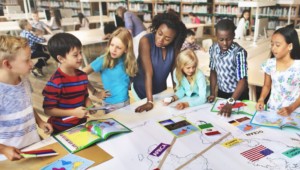It’s Student in Action, Not Inaction
The natural state of children is “in motion.” They are not simply pictures, they are motion pictures. A classroom full of third graders is a lot like a pool of sharks, except scarier. We are all aware of this natural state of activity yet we’ve managed to take our adult cubical workspace and force it upon the classroom.
In that cubical space, we have duplicated TV consumption with the “sage on a stage” or “lecture star.” Except we are pretty terrible at it. We seldom live up to all of the lecturing best practices, and many teachers have not had formal training in effective lecturing. We certainly aren’t as engaging as TV. Nevertheless, we’ve trained students to come in, sit down, consume our lectures, and then take tests to show that they consumed it.
Most of us current educators are from the TV generation. We consumed a lot of content. Today’s students, though, are from the Internet generation. (Watching TV now ranks third among teenagers in their media consumption behind the Internet and the new king: mobile devices.) This shift is important. It may seem that students have just moved from one screen to another, but the Internet allows students to interact with knowledge. They can comment on, mark as favorite, repost, like, forward, mix, remix, and curate content, and ultimately create new content. They can do all of that in a social way, too, and not just with their friends but with the actual authors of the original content. That’s not the TV generation.
Direct instruction will always have a place in education, but the sage on the stage needs to learn to balance that style with being a guide on the side. Students are already taking knowledge and sharing it on their own. They do this virtually everyday on the Internet. They rate, judge, comment, curate, create, and collaborate with people from across the world. Not only have schools not facilitated that, they have often acted as an intentional barrier.
So how can we amp up active learning in our classrooms? Certainly project based learning (PBL) is a good place to start. The Buck Institute for Education has created a great PBL overview:
PBL focuses on the “do” and kids love to do. Check out the arcade that Caine built:
Would a typical school capture and foster the “do spirit” of Caine? Can we even compliment his do spirit? Young Caine already understands economics and business better than I do, but I learned about economics the old fashion way: lecture and bubble tests. It wasn’t until I tried to sell my books back to the bookstore that I got my first real lesson in economics.
If your students need more class action, there are a number of web-based tools and apps that make “doing” and creating easier.

The Chrome apps are all free, and there are comparable apps in the iTunes store:
Everything doesn’t have to be project based to show active learning. Even traditional consumption activities like reading can be turned active with annotation lessons. Publishing is also a “do activity.” Project based learning can yield much better results than standard tests. This nine-year-old blogger changed her school and raised money for her charity through her blog Never Seconds.
Video Replaced the Lecture Star
The Internet has elevated the “do spirit.” Computers and web-based students have helped students become the creators of content and the producers of big multi-media projects. Science teachers have students videotape their labs to explain the process and results of their experiments. While tudents will make sure that their productions are “good enough” for teachers, they will make sure that they are flat out good for their peers.
The authors of Learning to Solve Problems with Technology see video production in all content areas as a way to promote meaningful learning. The idea is to not just teach with video production, but to also learn with video production. Students analyze, evaluate, and create when producing a video that showcases classroom content. In addition, students improve their digital literacy by using essential 21st-century multimedia skills in meaningful ways.
Daniel Matayas and Bryan Broder were the winners of the Texas High School Shorts division at Austin’s famous SXSW. Daniel talks about how inexpensive technology is making his job as a filmmaker easier:
Here’s another student in action:
High school students produced this video while studying the effects of drought: http://vimeo.com/43445310#
How many layers do you think the video production added to the studnets’ understanding of drought? I suspect a lot!
Kids are natural doers and they love to collaborate. Their potential and capacity to help one another can be astonishing:
The question is, are we ready to tap into that potential?
Next Level in Video Production
Check out this Google presentation to see a number of ways that students can use video in your classroom. Catalog the best productions to flip your classroom or tutor other students. The best videos can find their mark in any of the growing number of student video contests.
With all of these projects and videos now coming out of your classroom, your students and school will need a place to showcase all of this content. A portfolio tool like Digication allows that. Check out Eda’s portfolio here, and be sure to explore Stony Brook’s portfolio homepage for more examples.





0 Comments
Leave a Comment
Your email address will not be published. All fields are required.